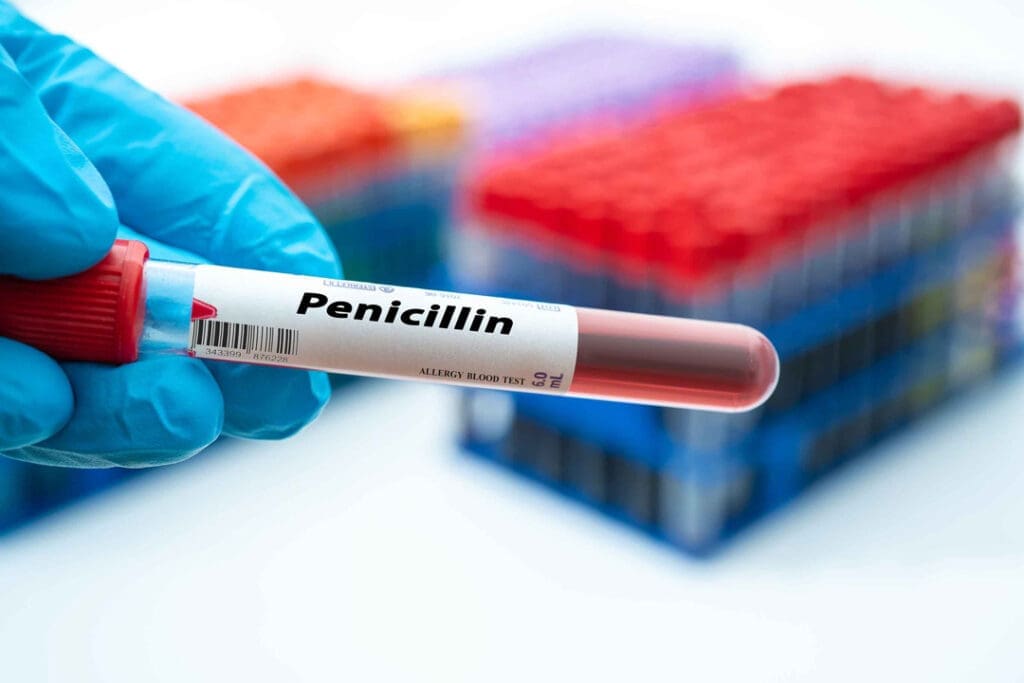De-labeling a penicillin allergy: improving safety and treatment quality
The documented penicillin allergy is often incorrect. Targeted de-labeling improves antibiotic therapy, reduces side effects and lowers the development of resistance. New strategies such as PEN-FAST and oral provocation tests facilitate the reliable exclusion of a penicillin allergy.

The challenge of a penicillin allergy
Penicillins are among the most effective and well-tolerated antibiotics. Nevertheless, a penicillin allergy is documented in the medical records of around 10% of the population. However, studies show that an average of 10% of those affected are actually allergic. This is usually because the reported symptoms are not due to an allergy but to an intolerance and an allergy does not last a lifetime. Approximately 80% of allergic IgE-mediated reactions disappear after 10 years. These misdiagnoses mean that patients often receive less effective second-line antibiotics, which promotes the development of resistance and increases morbidity and treatment costs.
The concept of delabeling
De-labeling describes the removal of a penicillin allergy label (PAL) after an allergy has been reliably ruled out. This is a key antibiotic stewardship measure. Studies have shown that many misdiagnoses can be quickly and safely revised through targeted anamnesis and risk-adapted test strategies, such as PEN-FAST or direct oral provocation tests (DOP).
Clinical decision tools: PEN-FAST and DOP
With the PEN-FAST clinical algorithm, the allergy risk is precisely assessed based on factors such as the type and time of previous reactions. Patients with a very low risk (0 points) can often be de-labeled directly. If the risk is low, a DOP enables an allergy to be ruled out with certainty. In studies, only 3.4% of the people tested showed an allergic reaction – no serious complications occurred.
The current situation in Germany
Despite international findings, there is a lack of established routines for de-labeling using medical history in Germany. An expansion of day clinic services for the implementation of DOP could also close this gap and lead to more effective antibiotic therapy. However, monitoring by qualified personnel remains crucial.
Conclusion
The de-labeling of penicillin allergies is a practical, safe and effective method for improving the quality of treatment. Innovative tools such as PEN-FAST and DOP could significantly increase patient safety and therapeutic success.
The Limbach Group supports you in all matters relating to de-labeling and modern antibiotic stewardship measures. Please do not hesitate to contact us for further information. Please contact us: infektiologie@limbachgruppe.com

Literature:
Trubiano JA, Cairns KA, Evans JA et al: The prevalence and impact of antimicrobial allergies and adverse drug reactions at an Australian tertiary center. BMC Infect Dis 2015; 15: 572.
Zhou L, Dhopeshwarkar N, Blumenthal KG et al: Drug allergies documented in electronic health records of a large healthcare system. Allergy 2016; 71 (9): 1305-13.
Blumenthal KG, Kuper K, Schulz LT et al: Association Between penicillin allergy documentation and antibiotic use. JAMA Intern Med 2020; 180 (8): 1120-2.
Blumenthal KG, Lu N, Zhang Y et al: Risk of methicillin-resistant Staphylococcus aureus and Clostridium difficile in patients with a documented penicillin allergy: population-based matched cohort study. BMJ 2018; 361: k2400.
Perez-Encinas M, Lorenzo-MartûÙnez S, Losa-GarcûÙa JE et al: Impact of penicillin allergy label on length of stay and mortality in hospitalized patients through a clinical administrative national dataset. Int Arch Allergy Immunol 2022; 183 (5): 498-506.
Kaminsky LW, Ghahramani A, Hussein R et al: Penicillin allergy label is associated with worse clinical outcomes in bacterial pneumonia. J Allergy Clin Immunol Pract 2022; 10 (12): 3262-9.
Mattingly TJ 2nd, Fulton A, Lumish RA et al: The cost of self-reported penicillin allergy: a systematic review. J Allergy Clin Immunol Pract 2018; 6 (5): 1649-54.e4.
Koch T, Leubner H, Brehm TT et al: Penicillin allergy: Safe and effective exclusion. Dtsch ûrztebl 2023; 120 (18): A-822 / B-699.
Trubiano JA, Vogrin S, Chua KYL et al: Development and validation of a penicillin allergy clinical decision rule. JAMA Intern Med. 2020; 180 (5): 745-752.
Wurpts G, Aberer W, Dickel H et al: S2k guideline: Diagnostics for suspected beta-lactam antibiotic hypersensitivity. Allergo Journal 2019; 28 (5): 19-51.
Cardoso-Fernandes A, Blumenthal KG, Chiriac AM et al: Frequency of severe reactions following penicillin drug provocation tests: A Bayesian meta-analysis. Clin Transl Allergy 2021; 11 (4): e12008.
Hornuss D, Rieg S: Antibiotic allergies – a targeted approach to suspected beta-lactam allergy. Internal Medicine 2023; 64: 351-361.
The respective companies are responsible for the content of the “Corporate News” section


